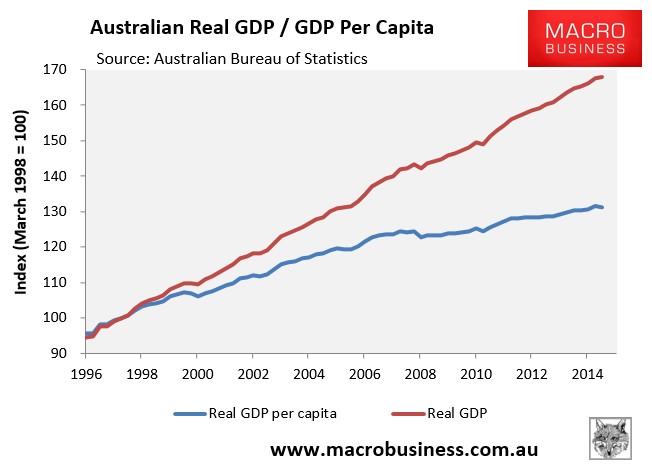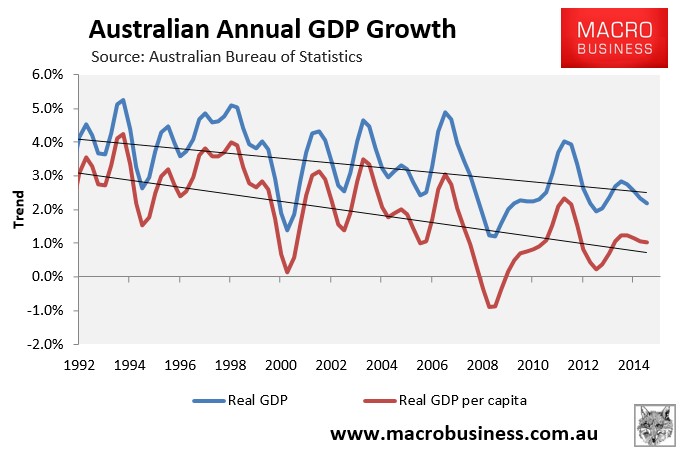The Australian Treasury is reportedly planning to release big downward revisions to Australia’s projected population growth rate as birth rates fall and the rate of net migration weakens. From The AFR:
Treasurer secretary John Fraser warned that a sharp slow down in expected population growth would mean the economy would grow at a slower-than-expected pace over the next 10 to 15 years.
The department is currently preparing significant research to be revealed by senior official Nigel Ray later this month that will show population growth estimates have been cut from 1.6 per cent to “more like 1.2 per cent,” Mr Fraser said…
He said this was not a short-term shift, but something that would unfold over the next 10 to 15 years, making it imperative that the nation “get off our backside” and revitalises productivity growth.
To say this is music to my ears is an understatement.
While most economists like to focus on aggregate GDP when assessing the state of the economy, I prefer to look at the per capita measures, since they provide a much better perspective on whether livings standards are increasing for the typical Australian.
After all, what is the point of growing the economic pie if everyone’s share of that pie is not increasing? And it is in this context that Australia’s fetish with population growth – on the basis that it stimulates headline GDP (more inputs equals more outputs) – runs into deep problems.
As shown in the next chart, around 70% of Australia’s growth in headline GDP since the GFC has come from growing the population:

Meanwhile, real GDP in per capita terms has been trending down strongly:

In effect, Australia’s high immigration program has maintained the illusion of growth, while everyone’s living standards slide backwards.
Readers might also recall that Infrastructure Australia recently forecast a massive 290% increase in the costs of congestion by 2031, unless there is massive investment in new roads and public transport:
The report says car travel times in the most gridlocked parts of Sydney, Melbourne, Brisbane, Perth, Adelaide and Canberra are expected to jump by at least 20 per cent if there no measures to boost capacity or curb demand.
“In some cases, travel times could more than double between 2011 and 2031,” the report says…
The report predicts public transport demand will more than double in Melbourne, and jump by 55 per cent in Sydney, and nearly 90 per cent across other capital cities.
“Unless peak period passenger loads are managed and capacity is increased, commuters in all capital cities will see more services experiencing ‘crush loadings’, where peak demand exceeds capacity,” the report says…
Hardly sounds like a recipe for growing living standards, does it? And yet our governments and mainstream economists continue to push on with the “growth is good” mantra, and attempt to funnel more and more people into Australia’s largest cities.
The costs of this approach are, of course, borne by you and I, who are forced to spend more time in traffic jams as Australia’s infrastructure – already straining after a decade of rampant immigration – fails to keep up with demand.
We will then be called upon to pay for expensive new infrastructure (e.g. roads, rail and desalination plants) in a futile bid support the rapidly growing population, but it will never be enough to maintain living standards.
This infrastructure investment can also lower productivity by diverting investment away from productive areas (see my previous post).
Our children and grandchildren will then be required to live in smaller and more expensive housing, often further away from the CBD, as more and more people flood into our major capital cities.
And then in 30 years time, they will be called upon to once again ramp-up the immigration intake once the current batch of migrants grows old and needs support – the very definition of a ponzi scheme.
About the only winners from the march towards a Big Australia, as advocated by both sides of politics and most economists, are big business, who enjoy an ever growing customer base and are able to increase sales without becoming more efficient.
We should also not forget that Australia earns its way in the world mainly by selling its fixed endowment of mineral resources (e.g. iron ore, coal, natural gas, and gold). More people means less resources per capita. A growing population also means that we must deplete our mineral resources faster, just to maintain a constant standard of living.
This is why we should celebrate the projected fall in Australia’s population growth rate, rather than lamenting it, since it equates to higher living standards for you and I.
As I have noted previously, if all Australia is doing is growing for growth’s sake, pushing against infrastructure bottlenecks, diluting our fixed endowment of minerals resources, and failing to raise the living standards of the existing population, what’s the point?
Perhaps the last word should be left to Treasury Secretary, John Fraser, who experienced the perils of inexorable population growth whilst living in the UK, and cautioned with the following [my emphasis]:
In recent years, Australia’s population growth has been amongst the fastest in the developed world, driven by migration.
A growing population can be a source of dynamism for the economy.
It provides a larger domestic market for business, increases the size of the labour force and facilitates the injection of new ideas.
But it also places additional demands on government budgets in areas such as infrastructure, health and education.
I have seen this firsthand in the United Kingdom where the results are very sobering.
unconventionaleconomist@hotmail.com

